Roles and Responsibilities in Maximizing Employee Performance
VerifiedAdded on 2023/06/16
|7
|1566
|380
AI Summary
This article discusses the importance of defining roles and responsibilities, setting performance expectations, and managing contingencies to maximize employee performance. It covers topics such as time management, work flow, and written communication, and includes a bibliography for further reading.
Contribute Materials
Your contribution can guide someone’s learning journey. Share your
documents today.
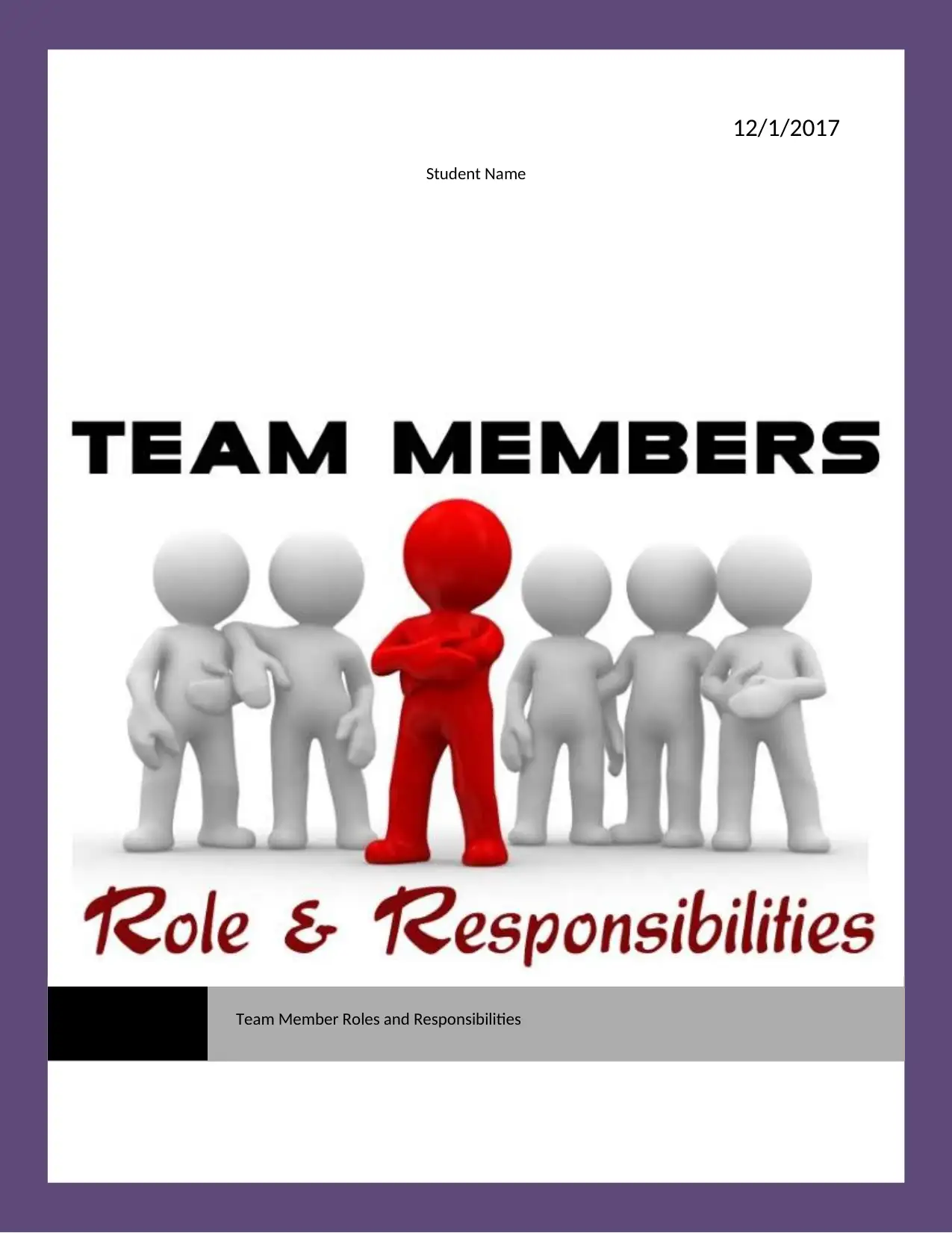
12/1/2017
Student Name
Team Member Roles and Responsibilities
Student Name
Team Member Roles and Responsibilities
Secure Best Marks with AI Grader
Need help grading? Try our AI Grader for instant feedback on your assignments.
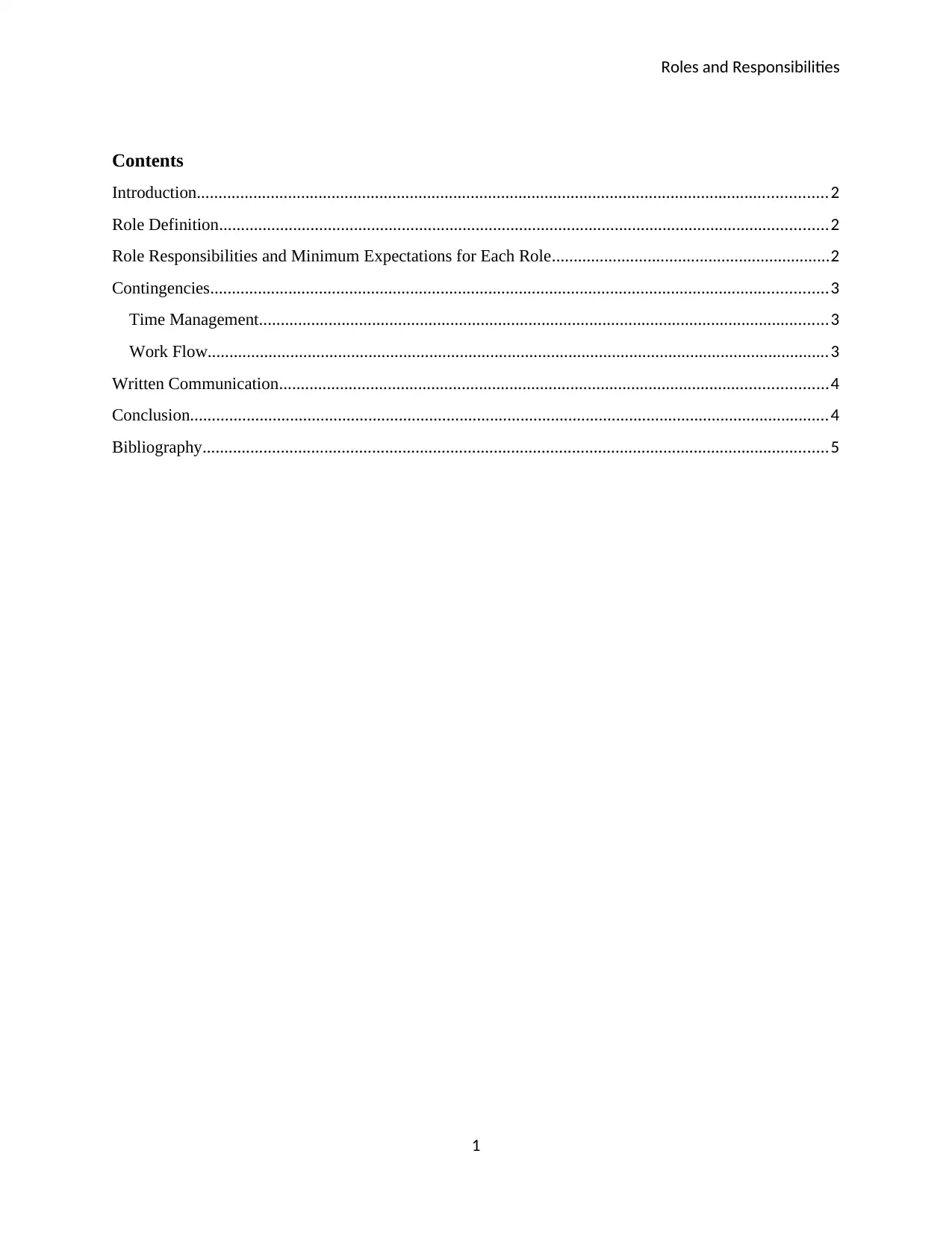
Roles and Responsibilities
Contents
Introduction.................................................................................................................................................2
Role Definition............................................................................................................................................2
Role Responsibilities and Minimum Expectations for Each Role................................................................2
Contingencies..............................................................................................................................................3
Time Management...................................................................................................................................3
Work Flow...............................................................................................................................................3
Written Communication..............................................................................................................................4
Conclusion...................................................................................................................................................4
Bibliography................................................................................................................................................5
1
Contents
Introduction.................................................................................................................................................2
Role Definition............................................................................................................................................2
Role Responsibilities and Minimum Expectations for Each Role................................................................2
Contingencies..............................................................................................................................................3
Time Management...................................................................................................................................3
Work Flow...............................................................................................................................................3
Written Communication..............................................................................................................................4
Conclusion...................................................................................................................................................4
Bibliography................................................................................................................................................5
1
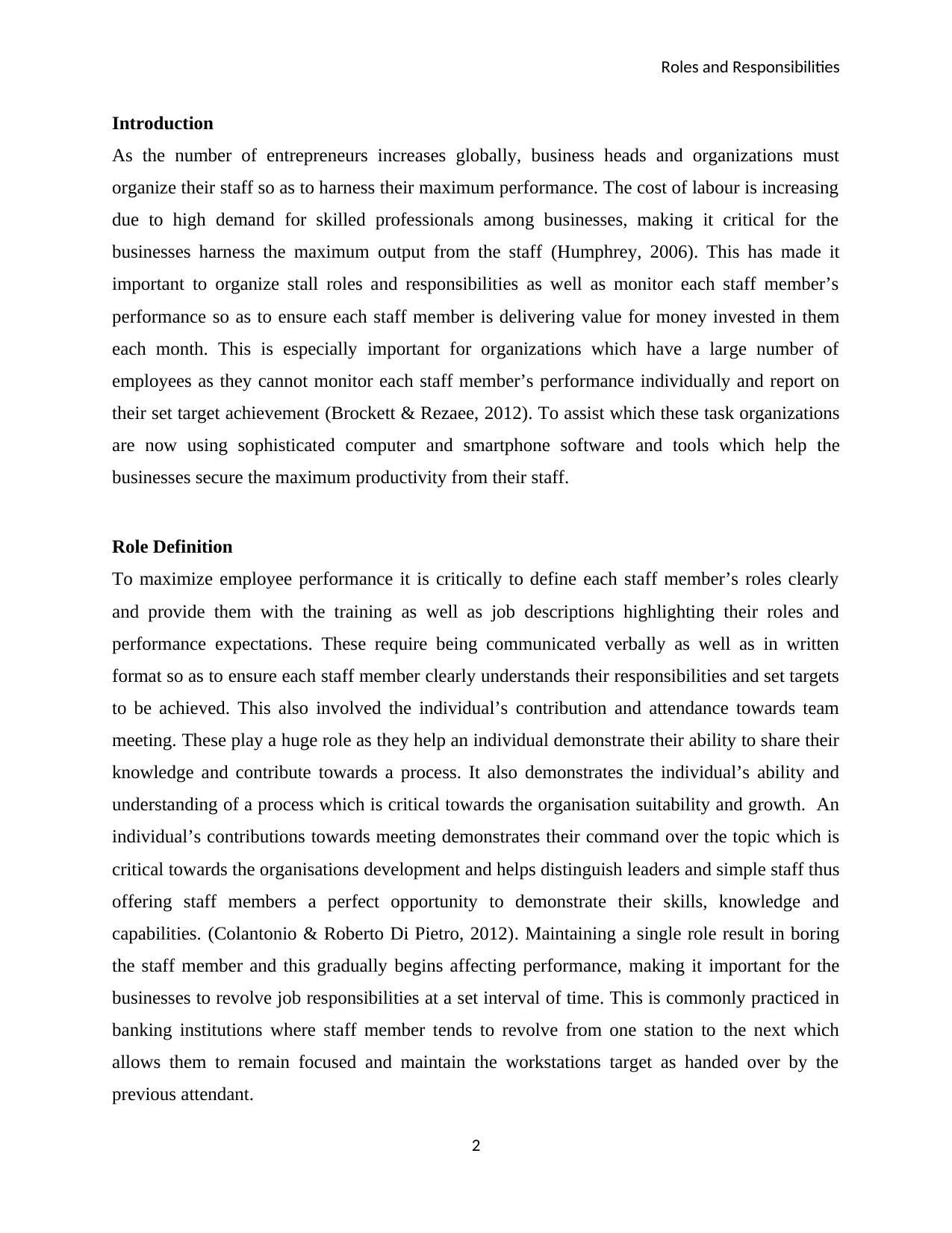
Roles and Responsibilities
Introduction
As the number of entrepreneurs increases globally, business heads and organizations must
organize their staff so as to harness their maximum performance. The cost of labour is increasing
due to high demand for skilled professionals among businesses, making it critical for the
businesses harness the maximum output from the staff (Humphrey, 2006). This has made it
important to organize stall roles and responsibilities as well as monitor each staff member’s
performance so as to ensure each staff member is delivering value for money invested in them
each month. This is especially important for organizations which have a large number of
employees as they cannot monitor each staff member’s performance individually and report on
their set target achievement (Brockett & Rezaee, 2012). To assist which these task organizations
are now using sophisticated computer and smartphone software and tools which help the
businesses secure the maximum productivity from their staff.
Role Definition
To maximize employee performance it is critically to define each staff member’s roles clearly
and provide them with the training as well as job descriptions highlighting their roles and
performance expectations. These require being communicated verbally as well as in written
format so as to ensure each staff member clearly understands their responsibilities and set targets
to be achieved. This also involved the individual’s contribution and attendance towards team
meeting. These play a huge role as they help an individual demonstrate their ability to share their
knowledge and contribute towards a process. It also demonstrates the individual’s ability and
understanding of a process which is critical towards the organisation suitability and growth. An
individual’s contributions towards meeting demonstrates their command over the topic which is
critical towards the organisations development and helps distinguish leaders and simple staff thus
offering staff members a perfect opportunity to demonstrate their skills, knowledge and
capabilities. (Colantonio & Roberto Di Pietro, 2012). Maintaining a single role result in boring
the staff member and this gradually begins affecting performance, making it important for the
businesses to revolve job responsibilities at a set interval of time. This is commonly practiced in
banking institutions where staff member tends to revolve from one station to the next which
allows them to remain focused and maintain the workstations target as handed over by the
previous attendant.
2
Introduction
As the number of entrepreneurs increases globally, business heads and organizations must
organize their staff so as to harness their maximum performance. The cost of labour is increasing
due to high demand for skilled professionals among businesses, making it critical for the
businesses harness the maximum output from the staff (Humphrey, 2006). This has made it
important to organize stall roles and responsibilities as well as monitor each staff member’s
performance so as to ensure each staff member is delivering value for money invested in them
each month. This is especially important for organizations which have a large number of
employees as they cannot monitor each staff member’s performance individually and report on
their set target achievement (Brockett & Rezaee, 2012). To assist which these task organizations
are now using sophisticated computer and smartphone software and tools which help the
businesses secure the maximum productivity from their staff.
Role Definition
To maximize employee performance it is critically to define each staff member’s roles clearly
and provide them with the training as well as job descriptions highlighting their roles and
performance expectations. These require being communicated verbally as well as in written
format so as to ensure each staff member clearly understands their responsibilities and set targets
to be achieved. This also involved the individual’s contribution and attendance towards team
meeting. These play a huge role as they help an individual demonstrate their ability to share their
knowledge and contribute towards a process. It also demonstrates the individual’s ability and
understanding of a process which is critical towards the organisation suitability and growth. An
individual’s contributions towards meeting demonstrates their command over the topic which is
critical towards the organisations development and helps distinguish leaders and simple staff thus
offering staff members a perfect opportunity to demonstrate their skills, knowledge and
capabilities. (Colantonio & Roberto Di Pietro, 2012). Maintaining a single role result in boring
the staff member and this gradually begins affecting performance, making it important for the
businesses to revolve job responsibilities at a set interval of time. This is commonly practiced in
banking institutions where staff member tends to revolve from one station to the next which
allows them to remain focused and maintain the workstations target as handed over by the
previous attendant.
2
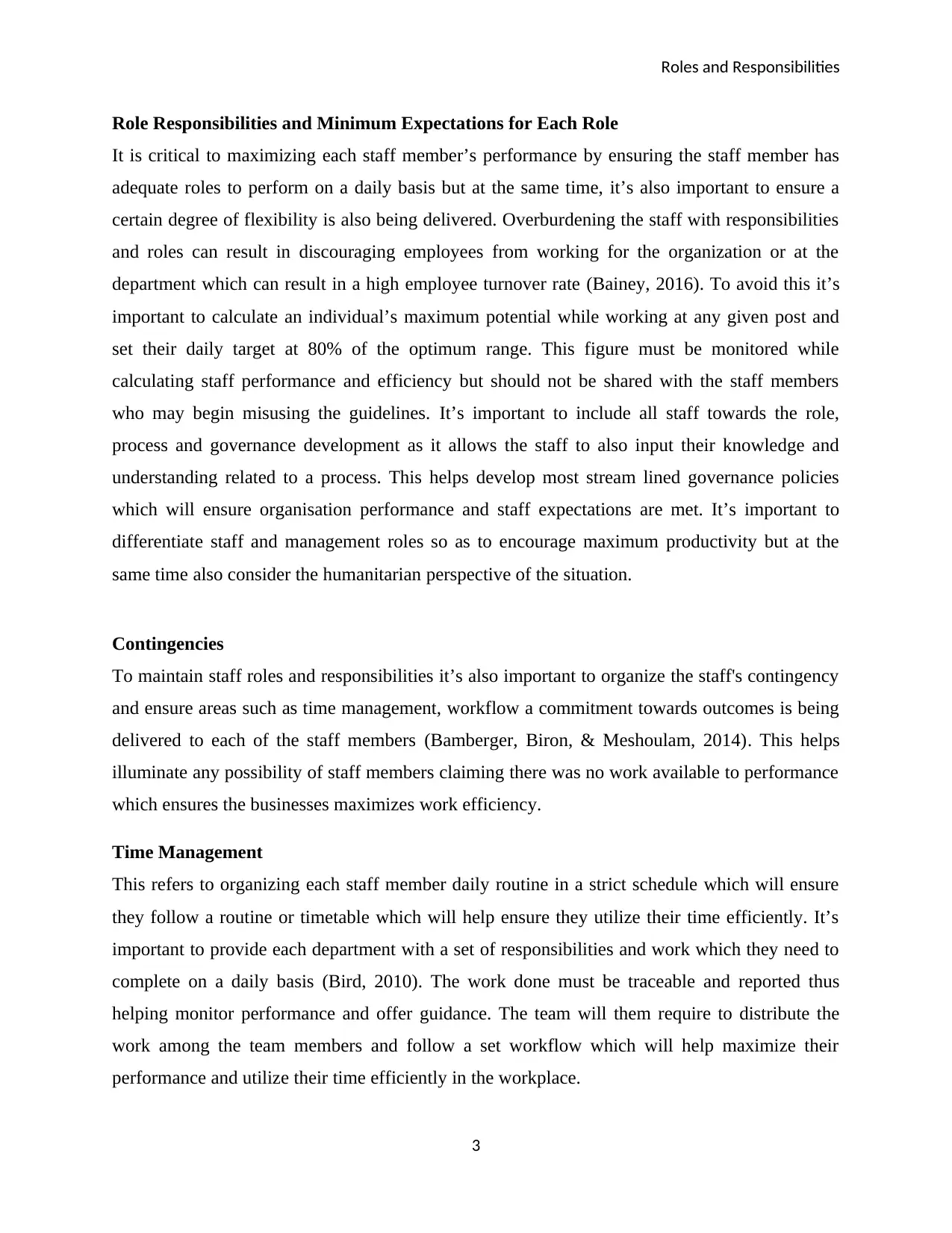
Roles and Responsibilities
Role Responsibilities and Minimum Expectations for Each Role
It is critical to maximizing each staff member’s performance by ensuring the staff member has
adequate roles to perform on a daily basis but at the same time, it’s also important to ensure a
certain degree of flexibility is also being delivered. Overburdening the staff with responsibilities
and roles can result in discouraging employees from working for the organization or at the
department which can result in a high employee turnover rate (Bainey, 2016). To avoid this it’s
important to calculate an individual’s maximum potential while working at any given post and
set their daily target at 80% of the optimum range. This figure must be monitored while
calculating staff performance and efficiency but should not be shared with the staff members
who may begin misusing the guidelines. It’s important to include all staff towards the role,
process and governance development as it allows the staff to also input their knowledge and
understanding related to a process. This helps develop most stream lined governance policies
which will ensure organisation performance and staff expectations are met. It’s important to
differentiate staff and management roles so as to encourage maximum productivity but at the
same time also consider the humanitarian perspective of the situation.
Contingencies
To maintain staff roles and responsibilities it’s also important to organize the staff's contingency
and ensure areas such as time management, workflow a commitment towards outcomes is being
delivered to each of the staff members (Bamberger, Biron, & Meshoulam, 2014). This helps
illuminate any possibility of staff members claiming there was no work available to performance
which ensures the businesses maximizes work efficiency.
Time Management
This refers to organizing each staff member daily routine in a strict schedule which will ensure
they follow a routine or timetable which will help ensure they utilize their time efficiently. It’s
important to provide each department with a set of responsibilities and work which they need to
complete on a daily basis (Bird, 2010). The work done must be traceable and reported thus
helping monitor performance and offer guidance. The team will them require to distribute the
work among the team members and follow a set workflow which will help maximize their
performance and utilize their time efficiently in the workplace.
3
Role Responsibilities and Minimum Expectations for Each Role
It is critical to maximizing each staff member’s performance by ensuring the staff member has
adequate roles to perform on a daily basis but at the same time, it’s also important to ensure a
certain degree of flexibility is also being delivered. Overburdening the staff with responsibilities
and roles can result in discouraging employees from working for the organization or at the
department which can result in a high employee turnover rate (Bainey, 2016). To avoid this it’s
important to calculate an individual’s maximum potential while working at any given post and
set their daily target at 80% of the optimum range. This figure must be monitored while
calculating staff performance and efficiency but should not be shared with the staff members
who may begin misusing the guidelines. It’s important to include all staff towards the role,
process and governance development as it allows the staff to also input their knowledge and
understanding related to a process. This helps develop most stream lined governance policies
which will ensure organisation performance and staff expectations are met. It’s important to
differentiate staff and management roles so as to encourage maximum productivity but at the
same time also consider the humanitarian perspective of the situation.
Contingencies
To maintain staff roles and responsibilities it’s also important to organize the staff's contingency
and ensure areas such as time management, workflow a commitment towards outcomes is being
delivered to each of the staff members (Bamberger, Biron, & Meshoulam, 2014). This helps
illuminate any possibility of staff members claiming there was no work available to performance
which ensures the businesses maximizes work efficiency.
Time Management
This refers to organizing each staff member daily routine in a strict schedule which will ensure
they follow a routine or timetable which will help ensure they utilize their time efficiently. It’s
important to provide each department with a set of responsibilities and work which they need to
complete on a daily basis (Bird, 2010). The work done must be traceable and reported thus
helping monitor performance and offer guidance. The team will them require to distribute the
work among the team members and follow a set workflow which will help maximize their
performance and utilize their time efficiently in the workplace.
3
Secure Best Marks with AI Grader
Need help grading? Try our AI Grader for instant feedback on your assignments.
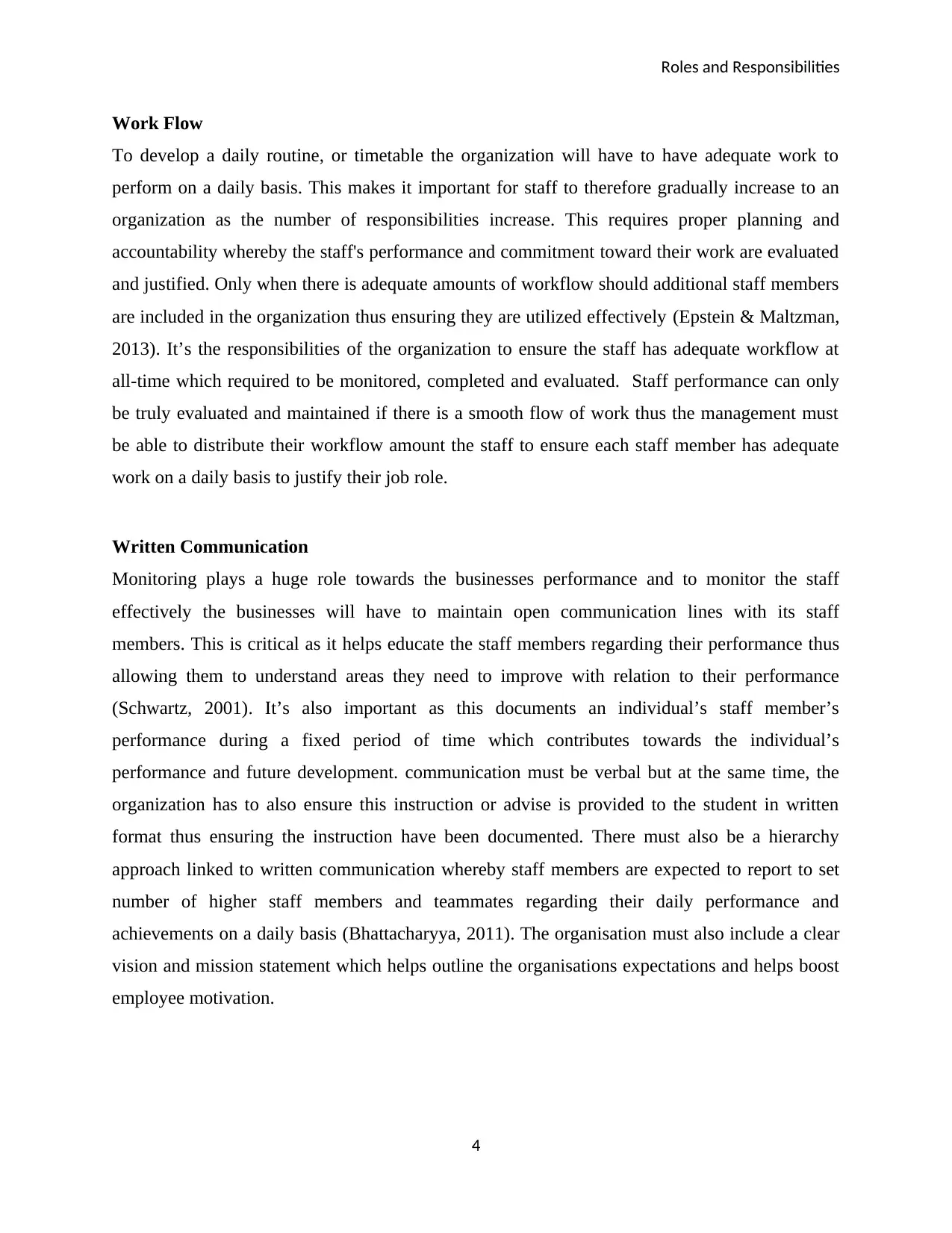
Roles and Responsibilities
Work Flow
To develop a daily routine, or timetable the organization will have to have adequate work to
perform on a daily basis. This makes it important for staff to therefore gradually increase to an
organization as the number of responsibilities increase. This requires proper planning and
accountability whereby the staff's performance and commitment toward their work are evaluated
and justified. Only when there is adequate amounts of workflow should additional staff members
are included in the organization thus ensuring they are utilized effectively (Epstein & Maltzman,
2013). It’s the responsibilities of the organization to ensure the staff has adequate workflow at
all-time which required to be monitored, completed and evaluated. Staff performance can only
be truly evaluated and maintained if there is a smooth flow of work thus the management must
be able to distribute their workflow amount the staff to ensure each staff member has adequate
work on a daily basis to justify their job role.
Written Communication
Monitoring plays a huge role towards the businesses performance and to monitor the staff
effectively the businesses will have to maintain open communication lines with its staff
members. This is critical as it helps educate the staff members regarding their performance thus
allowing them to understand areas they need to improve with relation to their performance
(Schwartz, 2001). It’s also important as this documents an individual’s staff member’s
performance during a fixed period of time which contributes towards the individual’s
performance and future development. communication must be verbal but at the same time, the
organization has to also ensure this instruction or advise is provided to the student in written
format thus ensuring the instruction have been documented. There must also be a hierarchy
approach linked to written communication whereby staff members are expected to report to set
number of higher staff members and teammates regarding their daily performance and
achievements on a daily basis (Bhattacharyya, 2011). The organisation must also include a clear
vision and mission statement which helps outline the organisations expectations and helps boost
employee motivation.
4
Work Flow
To develop a daily routine, or timetable the organization will have to have adequate work to
perform on a daily basis. This makes it important for staff to therefore gradually increase to an
organization as the number of responsibilities increase. This requires proper planning and
accountability whereby the staff's performance and commitment toward their work are evaluated
and justified. Only when there is adequate amounts of workflow should additional staff members
are included in the organization thus ensuring they are utilized effectively (Epstein & Maltzman,
2013). It’s the responsibilities of the organization to ensure the staff has adequate workflow at
all-time which required to be monitored, completed and evaluated. Staff performance can only
be truly evaluated and maintained if there is a smooth flow of work thus the management must
be able to distribute their workflow amount the staff to ensure each staff member has adequate
work on a daily basis to justify their job role.
Written Communication
Monitoring plays a huge role towards the businesses performance and to monitor the staff
effectively the businesses will have to maintain open communication lines with its staff
members. This is critical as it helps educate the staff members regarding their performance thus
allowing them to understand areas they need to improve with relation to their performance
(Schwartz, 2001). It’s also important as this documents an individual’s staff member’s
performance during a fixed period of time which contributes towards the individual’s
performance and future development. communication must be verbal but at the same time, the
organization has to also ensure this instruction or advise is provided to the student in written
format thus ensuring the instruction have been documented. There must also be a hierarchy
approach linked to written communication whereby staff members are expected to report to set
number of higher staff members and teammates regarding their daily performance and
achievements on a daily basis (Bhattacharyya, 2011). The organisation must also include a clear
vision and mission statement which helps outline the organisations expectations and helps boost
employee motivation.
4
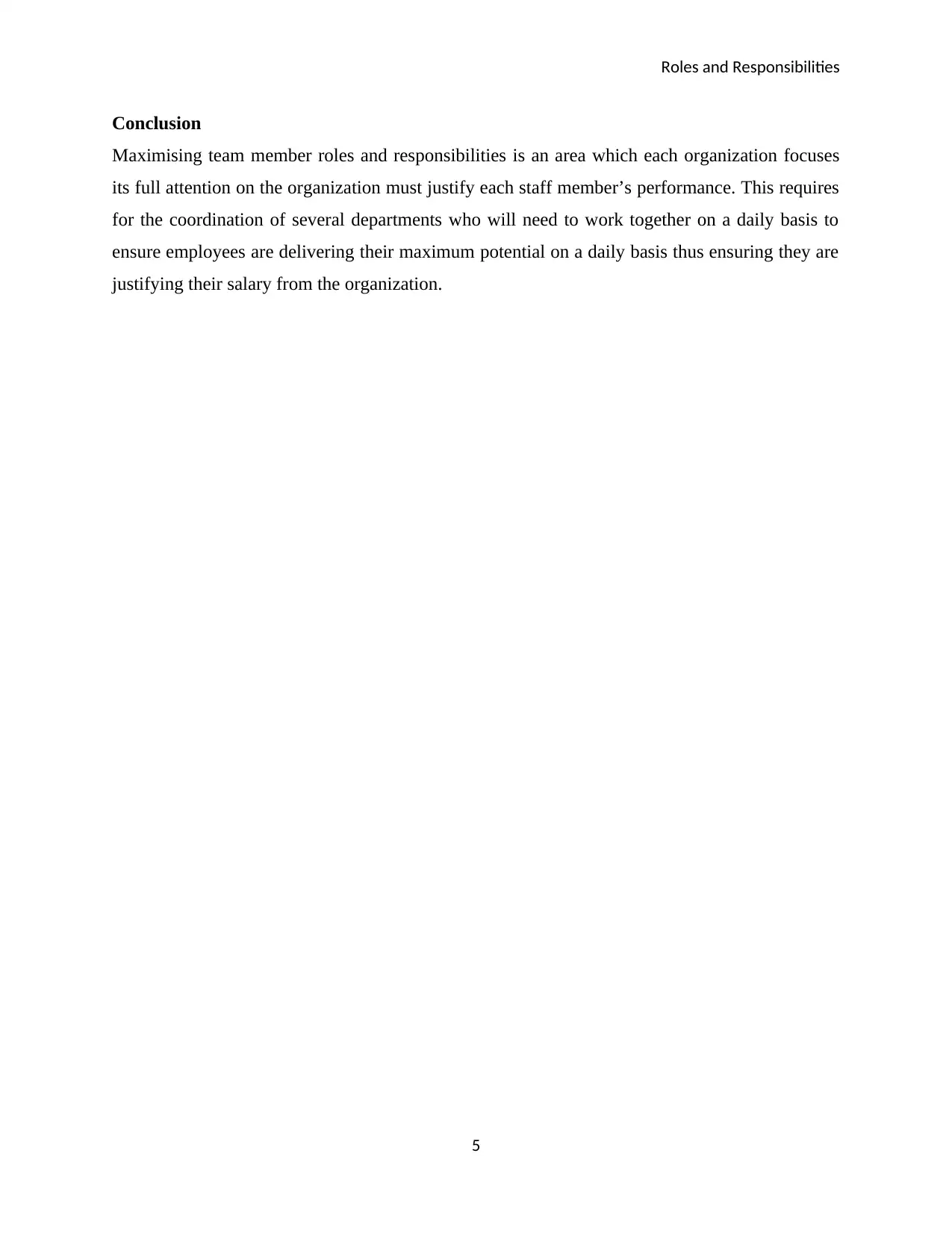
Roles and Responsibilities
Conclusion
Maximising team member roles and responsibilities is an area which each organization focuses
its full attention on the organization must justify each staff member’s performance. This requires
for the coordination of several departments who will need to work together on a daily basis to
ensure employees are delivering their maximum potential on a daily basis thus ensuring they are
justifying their salary from the organization.
5
Conclusion
Maximising team member roles and responsibilities is an area which each organization focuses
its full attention on the organization must justify each staff member’s performance. This requires
for the coordination of several departments who will need to work together on a daily basis to
ensure employees are delivering their maximum potential on a daily basis thus ensuring they are
justifying their salary from the organization.
5
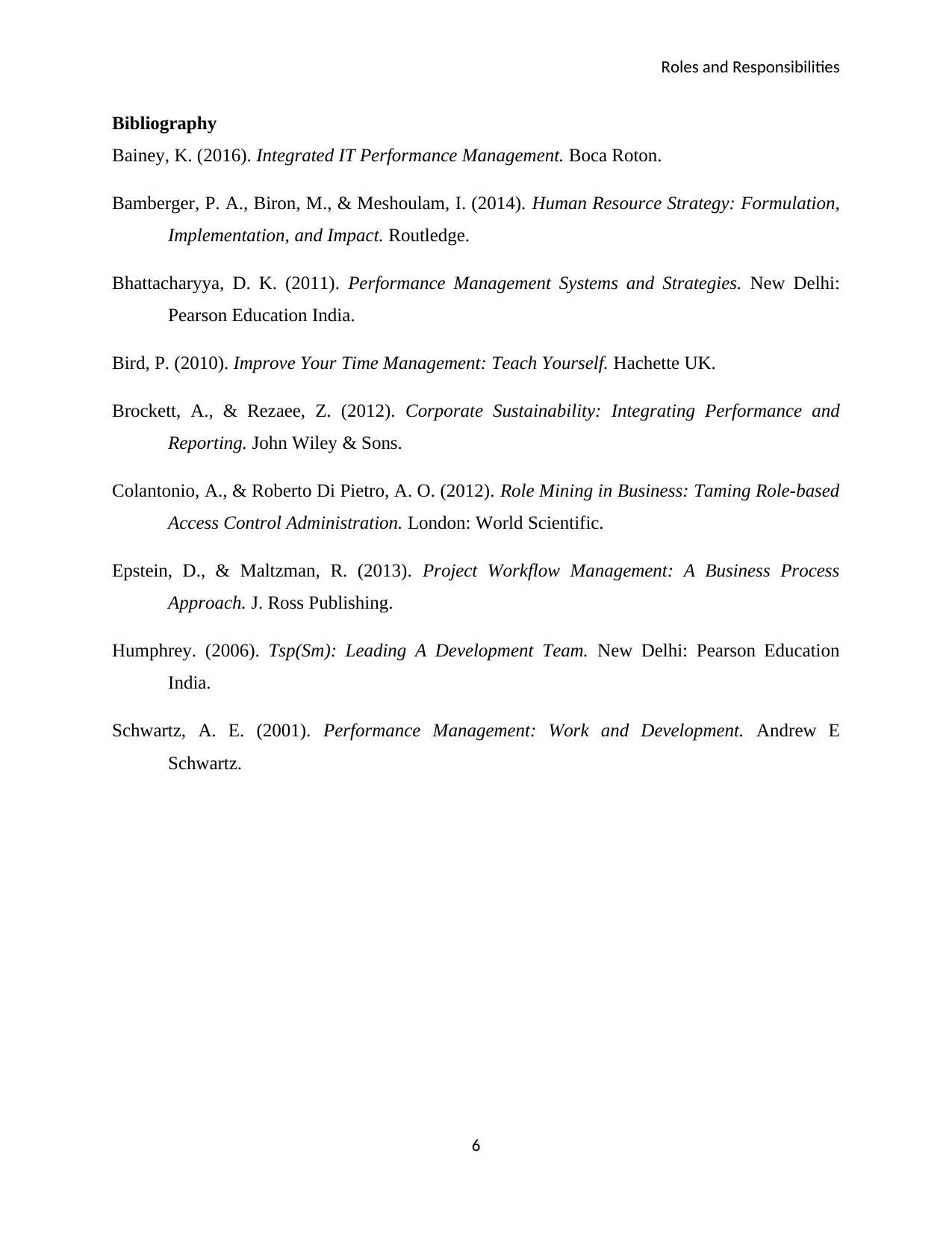
Roles and Responsibilities
Bibliography
Bainey, K. (2016). Integrated IT Performance Management. Boca Roton.
Bamberger, P. A., Biron, M., & Meshoulam, I. (2014). Human Resource Strategy: Formulation,
Implementation, and Impact. Routledge.
Bhattacharyya, D. K. (2011). Performance Management Systems and Strategies. New Delhi:
Pearson Education India.
Bird, P. (2010). Improve Your Time Management: Teach Yourself. Hachette UK.
Brockett, A., & Rezaee, Z. (2012). Corporate Sustainability: Integrating Performance and
Reporting. John Wiley & Sons.
Colantonio, A., & Roberto Di Pietro, A. O. (2012). Role Mining in Business: Taming Role-based
Access Control Administration. London: World Scientific.
Epstein, D., & Maltzman, R. (2013). Project Workflow Management: A Business Process
Approach. J. Ross Publishing.
Humphrey. (2006). Tsp(Sm): Leading A Development Team. New Delhi: Pearson Education
India.
Schwartz, A. E. (2001). Performance Management: Work and Development. Andrew E
Schwartz.
6
Bibliography
Bainey, K. (2016). Integrated IT Performance Management. Boca Roton.
Bamberger, P. A., Biron, M., & Meshoulam, I. (2014). Human Resource Strategy: Formulation,
Implementation, and Impact. Routledge.
Bhattacharyya, D. K. (2011). Performance Management Systems and Strategies. New Delhi:
Pearson Education India.
Bird, P. (2010). Improve Your Time Management: Teach Yourself. Hachette UK.
Brockett, A., & Rezaee, Z. (2012). Corporate Sustainability: Integrating Performance and
Reporting. John Wiley & Sons.
Colantonio, A., & Roberto Di Pietro, A. O. (2012). Role Mining in Business: Taming Role-based
Access Control Administration. London: World Scientific.
Epstein, D., & Maltzman, R. (2013). Project Workflow Management: A Business Process
Approach. J. Ross Publishing.
Humphrey. (2006). Tsp(Sm): Leading A Development Team. New Delhi: Pearson Education
India.
Schwartz, A. E. (2001). Performance Management: Work and Development. Andrew E
Schwartz.
6
1 out of 7
Related Documents
Your All-in-One AI-Powered Toolkit for Academic Success.
+13062052269
info@desklib.com
Available 24*7 on WhatsApp / Email
![[object Object]](/_next/static/media/star-bottom.7253800d.svg)
Unlock your academic potential
© 2024 | Zucol Services PVT LTD | All rights reserved.





